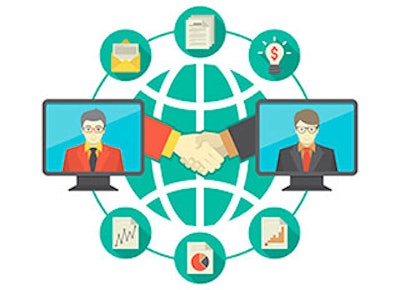
IT analyst firm IDC recently released its manufacturing predictions and it’s clear that omnichannel commerce is going to have a profound effect on the market for the foreseeable future.
IDC predicts manufacturers will move quickly to upgrade their IT systems and partnership strategies, both to be more competitive in their markets and expand into new ones. In fact, IDC is so certain of this prediction that it recently launched a new practice group, Manufacturing Commerce.
IDC's Research Manager for Manufacturing Commerce Strategies Heather Ashton and Simon Ellis, Manufacturing Insights Practice Director for Supply Chain Strategies presented their five-year forecast on manufacturing's role in ecommerce in a recent webinar. The key finding: Manufacturers will invest in a major overhaul of their IT systems to integrate and automate their back office and front office processes, from bookkeeping to web catalogues. More specifically, IDC predicts that:
Manufacturers will create "collaborative commerce networks" to facilitate B2B trade partnerships by making the ‘buy and sell’ processes faster and more efficient, and to appeal to their most strategic partners, whether those are customers or suppliers or, in some cases, both. These new collaborative commerce networks aren't the same as the B2B web communities or the point-to-point EDI integrations of the past. These are cloud-based networks for many-to-many connections amongst partners, with rich data interchange, process orchestration and collaboration.
Manufacturers will modernize their B2B infrastructures to support many-to-many connections and integration between IT systems.
What capabilities will be gained from modernization? Using NetSuite's B2B commerce platform as an example, manufacturers can gain a number of valuable capabilities, such as real-time inventory data, mobile access, multiple payment options like credit lines or ACH, integration with social media, support for negotiated prices for different customers, business intelligence tools, and business process management for creating and automating processes across applications. There must also be support for multiple languages, currencies, and tax laws — all necessary for doing business overseas.
Thanks to the advent of cloud-based computing, B2B commerce applications don't require the purchase of additional hardware or software, or need full time IT staffers to deploy and manage it. That will allow even small firms to implement B2B commerce.
Other key findings
To have more meaningful relationships with customers, manufacturers will offer extras such as social media and mobile commerce features to give customers more ways to communicate. They also want strategic channel partners and retailers who can help them get greater share of ecommerce growth. B2B commerce networks will create a wealth of data for manufacturers to analyze. Manufacturers will work to make it easier for partners and suppliers to join their communities by adding tools and services to facilitate on-boarding and supplier management.
How should manufacturers go forward in light of these predictions? Ashton and Ellis offered some specific advice for what businesses can do to get ready for this major overhaul of B2B trade.
For one, manufacturers should treat 2014 as a house keeping year to clean up data and processes and get ready for B2B integration over collaborative commerce networks. Another action item is to foster communication between the IT and the business sides of the organization, specifically to bring both of them together to identify priorities for new technology investments and help to build the business case for those investments.
Making a major technology migration may not be one that your firm can do this year, although the sooner you can make the move, the better. But one way to start the process is to begin integrating point solutions that you already have, such as your ERP and other back-office systems.
Take advantage of the systems and integration capabilities you can leverage to achieve what's possible, while preparing your organization for a more major platform overhaul in the coming year. The most important capabilities to nurture in your organization are flexibility and agility, which is something you can begin doing today.
Ranga Bodla is senior director of industry marketing, manufacturing and wholesale distribution at NetSuite.
To read more manufacturing and technology news, sign up for our newsletter. You can also follow Manufacturing Business Technology on Twitter @MBTwebsite.



















